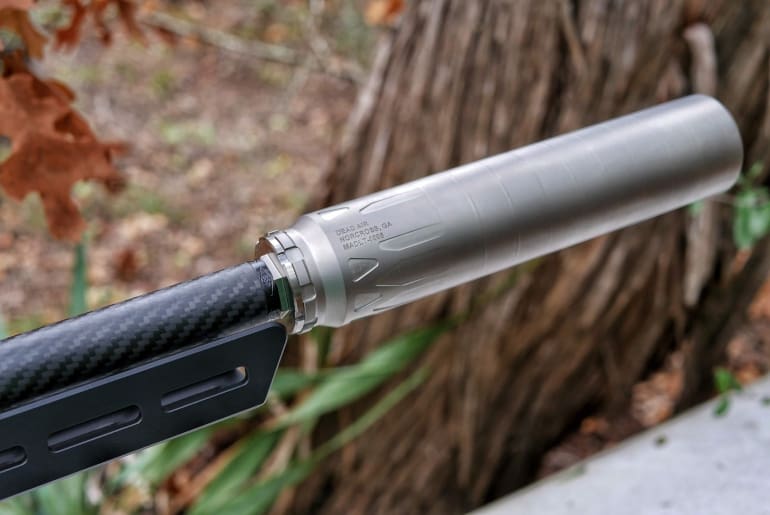
Dead Air’s new Nomad-LT is the latest offering in one of my favorite suppressor model lines, and this time around it’s exclusive to Silencer Shop.
In June of this year I reviewed the Nomad-Ti, which is a titanium version of the Nomad-30, and as you may have guessed the Nomad-LT seen here is the titanium version of the Nomad-L. It’s the quietest can in the Nomad lineup, but it’s still a featherweight.
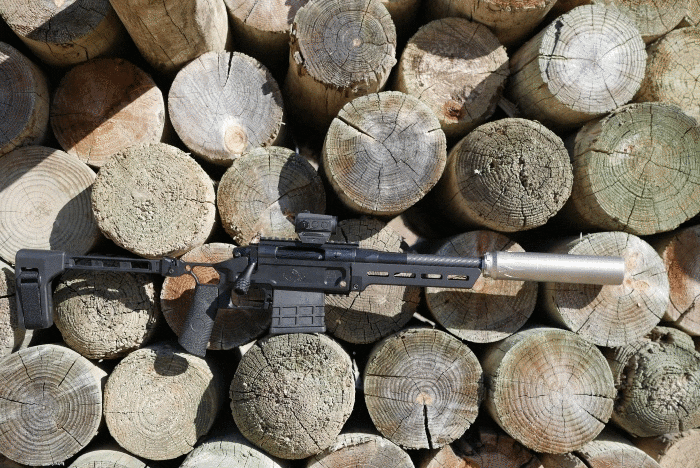
At a scant 12.6 ounces including the fixed thread mount, the Nomad-LT is undeniably a lightweight .30 caliber suppressor. It adds 1.9 inches to the length of the standard Nomad for a total length of 8.4 inches.
In exchange for that additional 1.9 inches of Grade 5 titanium, the shooter receives additional sound suppression. It’s perhaps most noticeable as you bump up in cartridge power level into the magnum cartridges such as .300 Win Mag, but its extra hush powers are apparent to the naked ear even when shooting subsonic 300 BLK.
Front caps are compatible with the rest of the Nomads, which are compatible with the Dead Air Sandman line of suppressors as well.
Snagging a Black Collar Arms Pork Sword Pistol tester gun (full disclosure: I co-own Black Collar), this one chambered in 300 Blackout with a 9-inch carbon fiber barrel, I liked how it created this look of dividing things into even thirds. The suppressor length, exposed barrel length, and action length are all nearly identical.
In my case, Silencer Shop loaned me a naked Nomad-LT — bare titanium — but they also offer it in black. As cool as the raw titanium is, perhaps black would have matched this particular Pork Sword’s outfit a bit better.
Somehow I neglected to take photos of the Nomad-LT on anything else, but I also shot it on my CZ 557 Urban Counter Sniper. The -LT is light enough that it doesn’t hurt the balance of a gun like this.
On the 300 Blackout, subsonic rounds are comically quiet. There’s little else on the entire U.S. market that can suppress a centerfire rifle round as well as this Nomad-LT, and running subsonic 300 BLK through it is straight silly.
Obviously testing this suppressor on bolt guns makes things even quieter by eliminating the action noise. Without it, firing a 300 BLK sub through the Dead Air Nomad-LT makes little more than a clack sound. Like tapping two hammers together, but perhaps a bit lower pitched.
Switching back and forth between the Nomad-Ti and Nomad-LT, the -LT was clearly quieter but not by as much as I expected. Basically, 300 BLK subs don’t benefit much from more suppression than what’s provided by the standard size Nomad, and adding a couple more baffles doesn’t bring a lot to the table. The Nomad-Ti is already silly quiet.
Over to the 16-inch .308 Winchester shooting standard 168 grain FMJ rounds and I was surprised to find more or less the same thing. Obviously this was much louder than the subsonic 300 Blackout, in part due to the significantly larger powder charge but in a larger part due to the supersonic crack of the projectile breaking the speed of sound, but I expected the Nomad-LT to noticeably pull ahead of the -Ti here and, at least to my ear, it wasn’t as big of a difference as I anticipated.
In both cases, this was an entirely comfortable combination. Despite what’s traditionally considered a short barrel for a .308, even the standard-length Nomad had zero difficulties taming it down to comfortable noise levels.
And that’s really the rub here: the Nomad-Ti is so dang efficient and so darn quiet that bumping up to the -LT on these guns didn’t add a whole lot more to the mix. The juice wasn’t worth the squeeze, if you will, in the form of a couple more inches and a couple more ounces.
Oddly enough, I swear when I shot the Nomad-30 and the Nomad-L back-to-back I noticed a larger difference between the two. I also found the Nomad-Ti to be quieter than the -30, which are identical except for material (Ti vs. 17-4 stainless steel, respectively), and must say that this later panned out in controlled dB testing by Silencer Shop and others. It makes sense, since Ti sucks heat out of the process markedly faster.
My guess is that the extra quietness of the Nomad-Ti has stolen some thunder from the longer variant on these perhaps too-easily-suppressed cartridges. From what I’m told, the Nomad-LT really comes into its own once you get into long action and, especially, magnum calibers such as .300 Win Mag. Thankfully it’s rated for up to .300 Norma Mag, so basically if the bullet fits through the hole you’re good to go.
Without a doubt, a 100 percent Grade 5 titanium suppressor has its advantages. It’s 31 percent lighter than the Nomad-L, the all 17-4 stainless steel version of the same can, which is nothing to sneeze at. I’ll also just go ahead and assume it’s a bit quieter as well, thanks to the aforementioned ability of titanium to more quickly remove heat from the muzzle gases.
That same heat sink ability, however, has a downside: these cans get hot and they get hot fast. Behind a magnified optic and without a suppressor cover, heat mirage becomes distracting to precision shooting after firing only a couple of groups. They’ll also be too hot to touch after only a few rounds. Granted, centerfire rifle rounds will get any suppressor right hot in short order, but it happens noticeably faster with titanium.
You’ll also want to keep an eye on your firing schedule. Really not a concern on a bolt gun, but with a suggested maximum temperature of about 800 degrees it has some rate of fire limitations on semi-autos, as all titanium suppressors do. The 17-4 stainless steel Nomads have effectively no concerns for any sort of semi-auto use you could throw at them, and are good to go for some full-auto use, too.
At the end of my testing of the entire Nomad line, I’ve decided that I like and prefer the titanium models for hunting use or, were I in a different profession, tactical use such as in a sniper role. The light weight is a huge benefit on long hunts, and the extra bit of dB reduction never hurts. For long action and/or magnum calibers I’d choose the -LT, for short action and smaller I’d go -Ti.
For effectively everything else, I’d choose a stainless steel Nomad. The ability to run it on an AR or other semi-auto without any real concern for rate of fire is pretty great, and because it heat soaks more slowly it takes longer to distract with its own heat mirage.
Dead Air is now four Nomads deep, and they’re all fantastic. But the original, the Nomad-30, is still my favorite for do-it-all use. Given the funds I’d unquestionably own two Nomads, though. The Nomad-30 would be my all-around can and the Nomad-Ti my hunting can. The longer variants have a place, of course, but as I personally weigh compact length more heavily than squeaking out a few more dB of sound reduction, I’d reserve them for use on larger cartridges than my current go-tos.
If that sounds like you, the Nomad-LT is pretty awesome and it’s a Silencer Shop exclusive, so head on over there to find one of their dealers near you.
Specifications: Dead Air Nomad-LT
Caliber: .30 cal and smaller (up to .300 Norma Mag)
Diameter: 1.735 inches
Length: 8.4 inches
Weight: 12.6 oz.
Mount Type: 1.375×24 universal mounting threads. Comes with 5/8×24 fixed mount.
Materials: 100% 6Al-4V Grade 5 Titanium
Finish: raw titanium satin bead blast (also available in black)
MSRP: $1,149 (find it for less at Silencer Shop)
Ratings (out of five stars):
Utility * * * *
With the now-ubiquitous 1-3/8×24 mount threads and swappable end caps, the Nomad-LT is highly adaptable. Its titanium construction prevents a five-star rating due to the necessary rate-of-fire limits that come with it.
Form Factor * * * *
Shockingly lightweight for its size, the machining and laser weld quality are great, and I dig the nearly one-and-three-quarter-inch diameter. I like the good looking simplicity of the Nomad line.
Suppression * * * * *
The entire Nomad line is insanely quiet, and the Nomad-LT is, I believe, the quietest of them all. It’s one of the very quietest .30 caliber silencers on the market.
Overall * * * *
The Dead Air Nomad-LT is an awesome suppressor. I just happen to like the shorter Nomad-Ti and Nomad-30 one star better for my use.

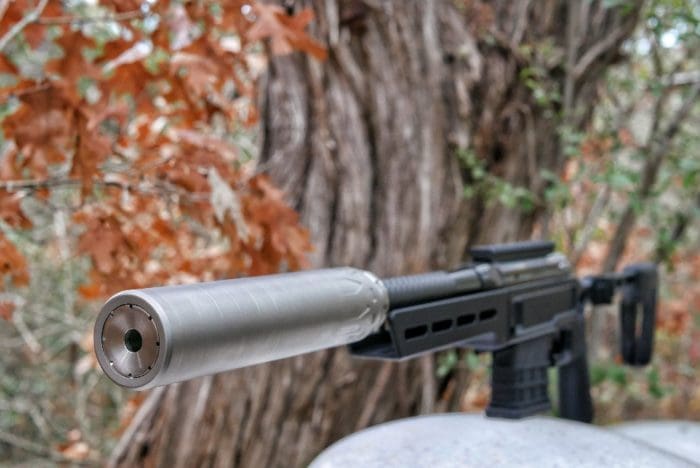

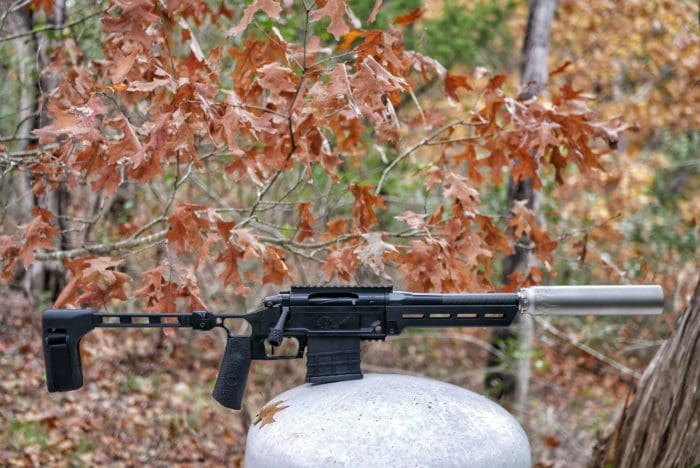

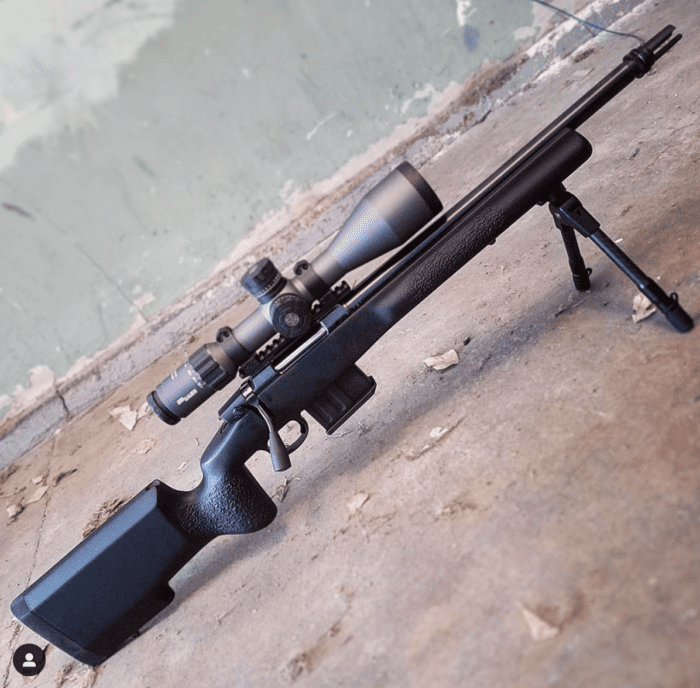




Shhhh Be veawe veawe quiet he’s hunting wabbits.
Titanium does not conduct heat as well as stainless. The sound properties probably have more to do with the mechanical properties not the titanium than thermal.
Thermal conductivity is about 42% higher with titanium than stainless, but you’re right that it’s lower than I recalled. I thought it was up there with aluminum and it’s WAY far from that (much, much closer to that of steel).
It’s also possible that certain wall thicknesses in the Ti Nomads are thinner than in the stainless Nomads, plus regardless of that there’s definitely less mass in the Ti ones, and in both of those cases it would lead / does lead to the Ti cans heating up faster even if the thermal coefficient were the same.
Regardless of the physics behind it, the Ti can absolutely does heat up faster and it also absolutely is quieter, so those things are considerations to think about if you’re shopping for one.
“Regardless of the physics behind it, the Ti can absolutely does heat up faster…”
If both the stainless and Ti cans were exposed to the same thermal ‘load’ (a blast of mostly-contained gunshot combustion gasses), it makes sense the one with a lighter total mass would heat up faster. And probably cool faster, as well.
Either way, nice can. Us ‘poors’ get to make do with our crappy ChiCom aluminum E-File Form-1 ‘permission slip’ NFA toys.
(I need to learn how to play the banjo and hang out on Possum’s front porch and sip ‘MoonShine’… 😉 )
Now that I’m putting some thought into this is is getting complicated fast!
Volumetric heat capacity of titanium (assuming both cans are identical except material) is about 2/3 that of steel. But we need to consider the thermal effusivetivity. Which is the ability to exchange heat with the surroundings.
That is much lower in titanium as it is related to the conductivity (1/3 of stainless) and density (2/3 that of steel).
Here is where the back of the napkin math has its limits. You’ve got 5000deg inputs for a short amount of time and it’s immersed in atmosphere to remove the heat.
My guess is the titanium will cool more slowly and have higher peak temps as the heat in it spreads less quickly.
Why it is quieter, because titanium is awesome and full of good magic.
Regardless of the math and technical aspects the lighter weight is going to be better for all but the most intense firing schedule.
Nomad LT is ok my list under a turbo k for my next cans.
So, what happens if you exceed 850 degrees? IIRC, titanium changes color when heated to certain temperatures, I have heard rumors that the SR-71 spy plane (titanium skin) rolled out for first takeoff silver, came back an hour later black. Is there another reason to avoid higher temperatures? ‘Cuz I wouldn’t care what color it became, those SR-71s kept flying real fine for 40 years.
Nice looking gun!
As metal heats up it loses strength. Rule of thumb for titanium suppressors is to keep them under 800 degrees to avoid bore erosion and such.
Titanium is subject to a problem called Alpha Case where when it is heated over certain temperatures about 900F it allows oxygen atoms to get between the grain boundaries which results in a very hard but very brittle layer which is prone to cracking. If you have bare metal you will see it turn purple/blue and then to a straw color. The purple/blue is ok the straw color means you are starting to have alpha case issues. The SR-71 used other materials in the really high temp locations. Either nickel superalloys like rene-41 or inconel or some steels the only problem with steel is that it has corrosion issues. Titanium is used for light weight not temperature resistance. I work as an engineer for the USAF and we throw a lot of dollars worth of titanium jet engine components away every year when we get engine overtemps due to this issue.
SR ran about 3500 fps, pretty good muzzle velocity. I hear the fuel was routed to the engines thru the wing’s leading edges to help cooling (even though air temp is something stupid like -150, chill factor negative infinity) and the leading edges still glowed cherry red. I suspect that despite common knowledge saying “titanium”, there were significant quantities of alloy mixed in there. Someday we’ll know. But I never heard of any erosion problems.
Not being picky, those are very fine set ups, hated carbon fiber barrels until using one. But can you tell me why a 16inch barrel .308, I’d think portability versus more muzzle velocity with less muzzle blast would not be of benefit.
I am a bit of a Dead Air fan, and I have been eyeing the Nomad series for a while (to add to my Mask22, Sandman-S and Sandman-K). This seems like an ideal candidate for my PRS rig that occasionally doubles as a long range hunting setup. The extra length wouldn’t be an issue on that rifle since it is pretty husky as is, and the modular mount would allow me to screw it onto an Area 419 Hellfire system for when I’d rather run a true brake.
Nice review!
The Marine Corps Has Started Fielding 30,000 Rifle Suppressors to Combat Units
(Marine Corps Systems Command began fielding the first 13,700 Knight’s Armament Company suppressors)
https://news.yahoo.com/marine-corps-started-fielding-30-211125673.html
Fine. Fine. I’m tired of hearing how fantastic the Nomads are … I just went over to SilencerShop right now, ordered one, and will just have to hear/not hear it myself. Plus, $100 promo right now makes for half price tax stamps … hard to beat!
Thanks for the honest, no-BS review!
the Titanium Nomads are tested to be slightly louder than their 17-4 counterparts. pew science and Thunderbeast have metered results to show this. but it’s not by a whole lot. The Titanium advantage is just reduced weight.